Talking to screenwriter Phyllis Nagy about her upcoming film Carol is a lesson in commitment. When she began the work to adapt Patricia Highsmith’s novel The Price Of Salt it was 1997. In the land of independent filmmaking, it’s not uncommon for a movie to languish in development hell for years before the money, the team, and the distribution come through, and for every story of a miracle happening, there are countless projects that remain anonymous and incomplete. Thank goodness then for the magic touch of director Todd Haynes, in whose hands Carol has been delivered safe and sound.
“When Todd came onboard, I did what you do when your script can become a movie,” stated Nagy in an interview with The Daily Beast. “You change it to what the director needs. And I don’t think you can argue with the results.”
It only took 18 years, but this is the year Carol left the nest. And after months of anticipation following the film’s warm reception at the Cannes Film Festival, Todd Haynes’s Carol is finally on its way to theaters.
ADVERTISEMENT
Carol is a story of love in 1950s New York, and the parties to that love are played by Cate Blanchett and Rooney Mara. If the attraction between the two characters is immediate, so too is the encroachment of the impediments that threaten to stop that attraction from ever blossoming into love. Carol and Therese are from different classes, there is an unbreachable gap of age and experience between them, and of course they are both women in a time when even finding the language for love between women was impossible.
Highsmith was a crime writer, and her books have proved to be some of the most adaptable in the American literary canon, as the quality of films like Strangers on a Train, Purple Noon, The Talented Mr. Ripley, and now Carol can demonstrate. In her crime novels, Highsmith locked the reader in what Haynes calls “the overproductive mind of the criminal”—she turned her readers into voyeurs as her murderers, liars, and thieves plotted the potential outcomes of their transgressions.
Carol is no different, but this time it’s the lover who is criminal, both literally due to laws around homosexuality in the 1950s, but also psychologically. A lover’s mind pores over the clues and the signals of their potential partner much like a murderer with their victim, each searching for the one opportunity out of a thousand that will unlock the door to their desires.
This temporary insanity that Highsmith depicts is a universal experience, one that happens to any lover, regardless of the gender of their desired partner—but love as a feverish obsession that might strike at any moment, forcing its victim into the margins of society as they’re consumed by uncontrollable and hyperactive passion? That’s hardly the construction of love that we have come to expect from the movies. But if ever there was a filmmaker who would be able to marry Highsmith’s desiring outsider with a cinematic rigor to match the adaptations of her work that have come before, it’s New Queer Cinema graduate Todd Haynes.
In Haynes’s hands, Carol is a perfect film. It’s so perfect that perfect seems like a profanity. To call Carol the best film of the year would trivialize the experience of watching it, to limit the metaphysical frenzy of Carol to the banal realm of a physical world where studios make movies and put them in theaters for audiences to chew popcorn and critics to take notes and Academy members to anoint the year’s prize pony. There are movies and then there is Carol, and part of the sheer wonder of Carol is in the rush of realizing that, by god, there’s still some magic left to find at the movies.

Carol is a film that stands as a testament to the value of creative collaboration. From cinematography to editing to costumes, every collaborator is working in tandem at such a superhuman level of excellence that each surface of the image and each millisecond of its life onscreen becomes infused with meaning.
In a discussion at Lincoln Center this week, Haynes opined that despite Carol’s intentionally cramped and dingy interiors, people keep congratulating him on the film’s glamour. But their confusion is only one of cause, not effect. It’s not Carol’s setting but its construction that feels luxurious. Every choice feels like it was made, not only without compromise, but with an infinite expanse of time to deliberate.
So barring the possibility of divine intervention, how is it that a film like this comes together?
“Well,” Haynes offered in an interview with The Daily Beast, “we shot the film in 34 days.”
Infinite expanse of time be damned.
“Everything has to be considered. Everything is a creative decision that has to be priced out and really determined by an overall aesthetic and language, and that’s where you begin.”
It’s a sign of Haynes’s generosity that he’d assume everyone would begin a film the way he does: creating languages out of images as if cinema was something that could still be pure in the age of Marvel and corporate conglomeration and streaming. Given enough time, not even queerness has been able to avoid the mainstream, but art—real art—will always be for outsiders.





